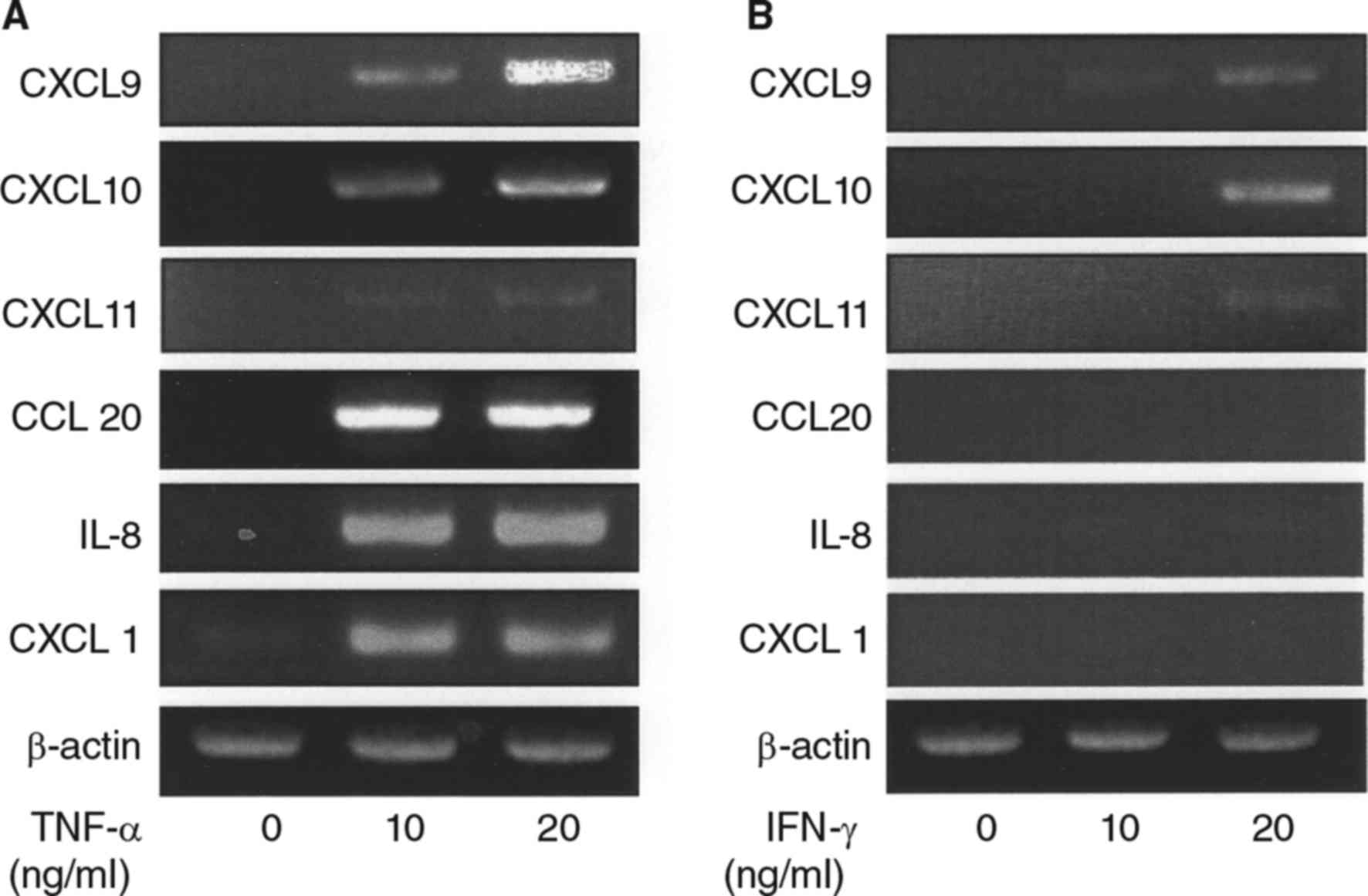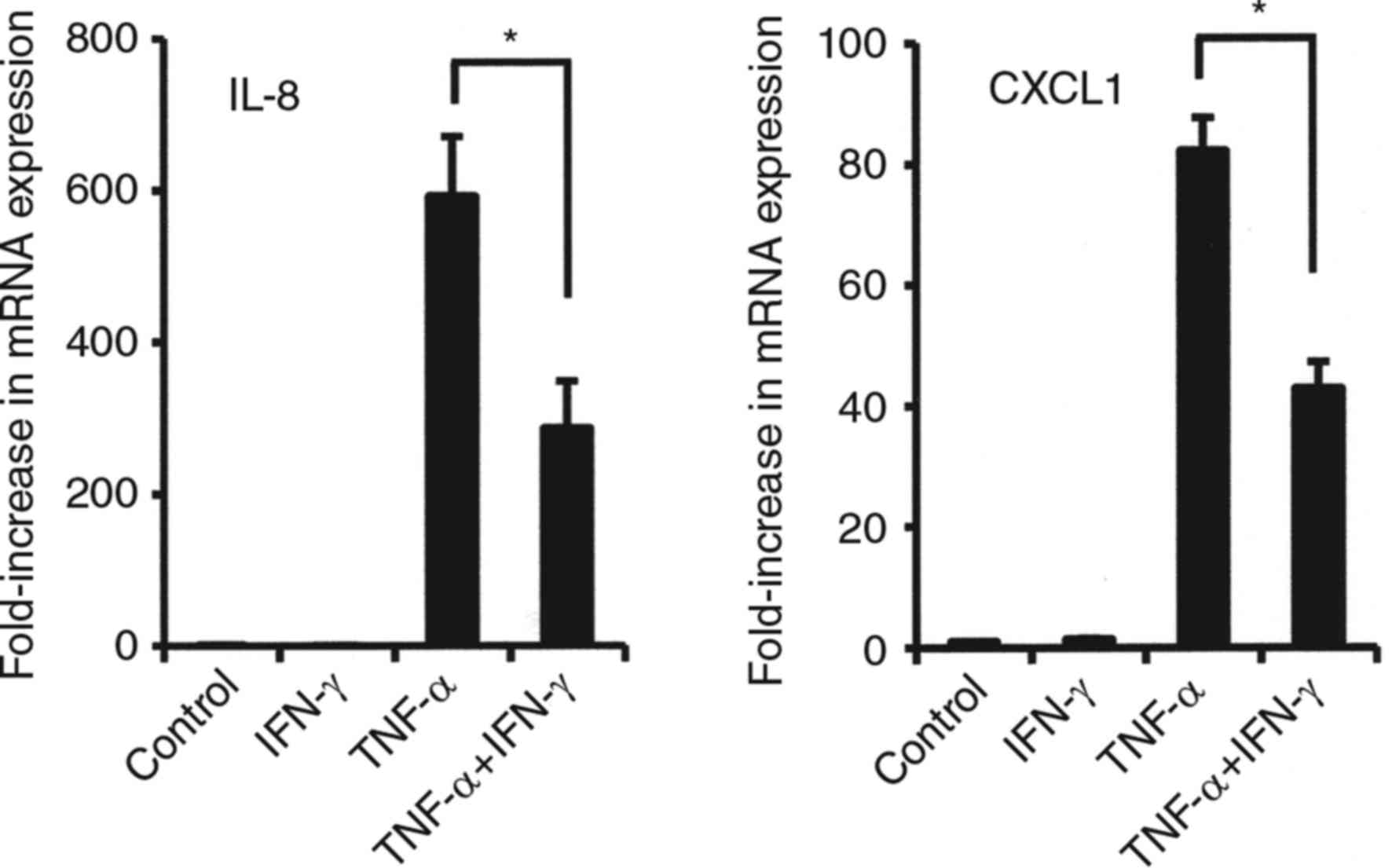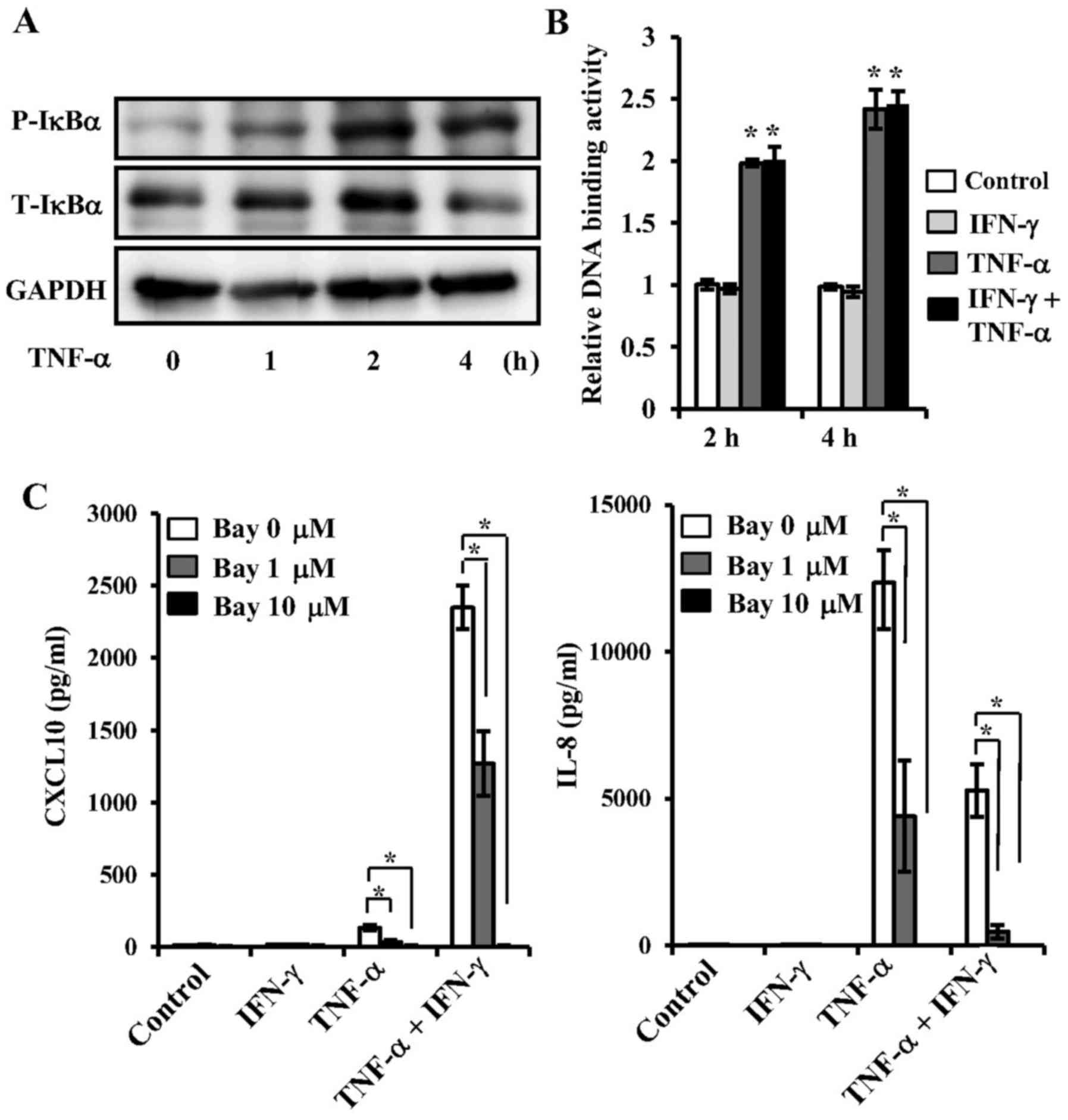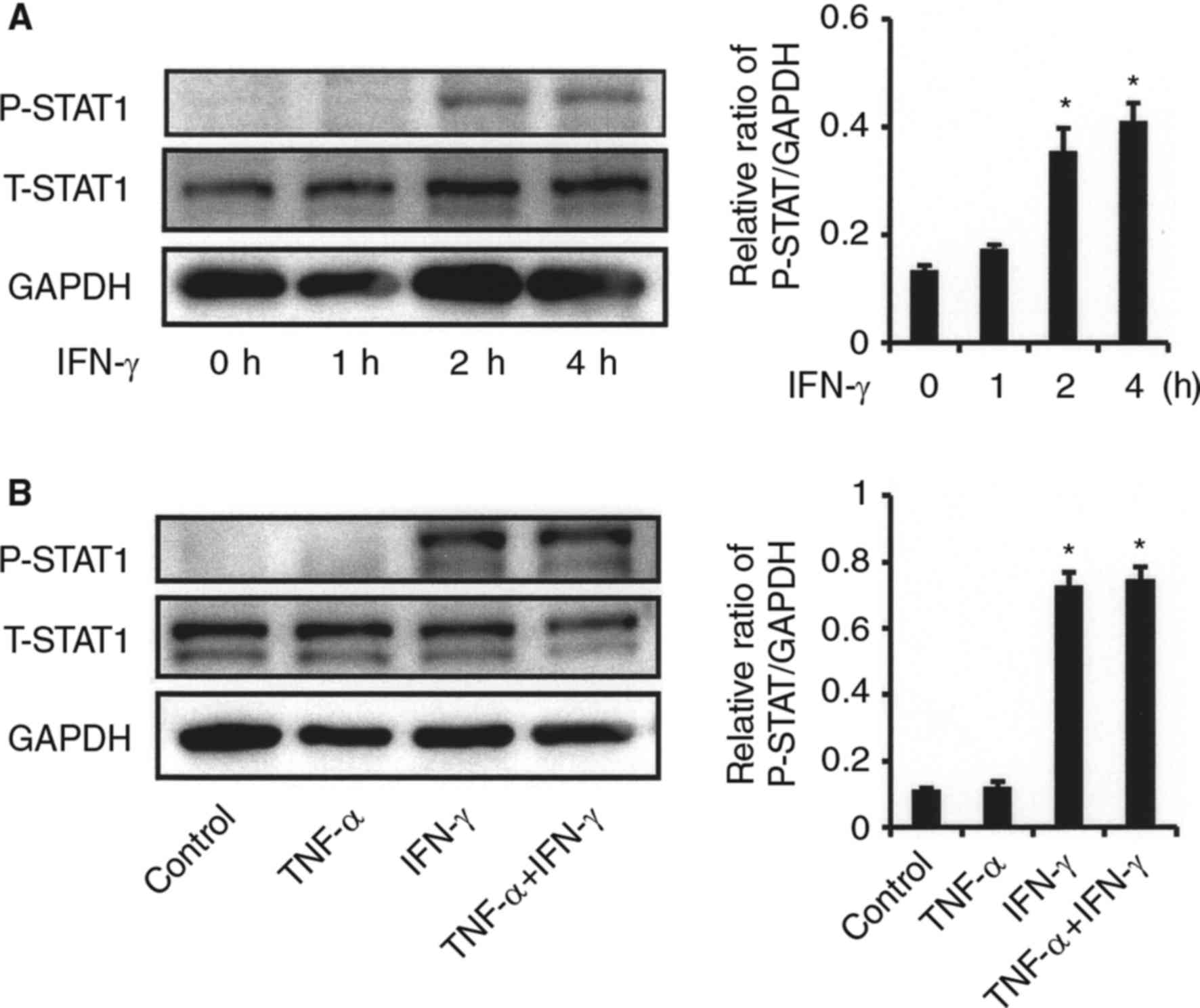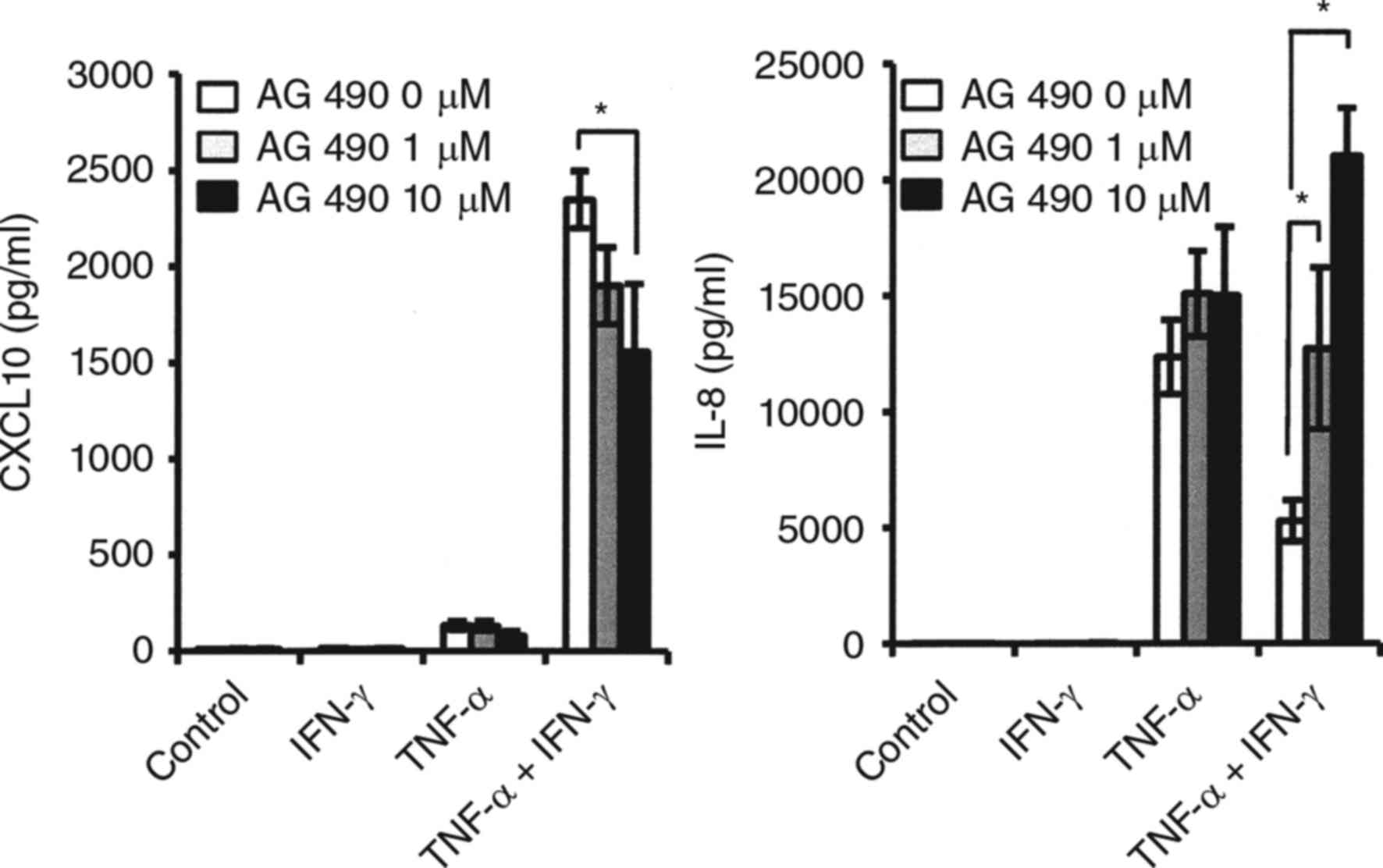Differential regulation by IFN‑γ on TNF‑α‑induced chemokine expression in synovial fibroblasts from temporomandibular joint
- Authors:
- Published online on: September 7, 2017 https://doi.org/10.3892/mmr.2017.7432
- Pages: 6850-6857
Abstract
Introduction
The temporomandibular joint (TMJ), a synovial joint, similar to other articulating joints in the human body, provides diarthrodial articulation between the mandibular condyle and temporal bone. Its synovial membrane covers all of TMJ intra-articular structures, except for the articular cartilage of the eminence, fossa and mandibular condyle, and the articular disc (1). Pathological conditions of the TMJ, such as internal derangement and/or osteoarthritis, in patients with temporomandibular joint disorder (TMD) have been reported to be accompanied by inflammation of the synovial membrane (2,3). Synovitis, is defined as inflammation of the synovial membrane and characterized by chronic inflammatory changes, such as hyperplasia of the synovial lining as well as increases in new capillaries and small vessels along with immune cell infiltration (1), while various inflammatory mediators, such as cytokines have been detected in synovial fluid and tissue samples obtained from affected patients (4,5). Inflammatory mediators that modulate the functions of cells that compose the synovial membrane, such as synovial fibroblasts are considered to promote and shape the pathological condition of the TMJ.
TNF-α is produced by monocytes and macrophages, and known to be a pro-inflammatory cytokine with roles in inflammatory mediation and immune response (6). Furthermore, reported evidence has shown that this cytokine likely mediates acute and chronic inflammation associated with connective tissue degeneration in TMD. Indeed, TNF-α has been detected in the synovial fluid of patients with TMD (4,5), while transgenic mice with over-expression of TNF-α were found to develop remarkable arthritic changes in the TMJ (7). In other studies, TNF-α was reported to increase inflammatory chemokines, small peptides that induce leucocyte activation and migration, such as IL-8 and CCL20, in synovial fibroblasts obtained from patients with TMJ (8,9). On the other hand, IFN-γ is also known as a Type II interferon produced by T-lymphocytes and natural killer cells (10). Although IFN-γ as well as TNF-α have been found in synovial fluid samples from TMD patients, in contrast to those from healthy individuals (5), it is unknown whether either participates in induction of inflammatory chemokines, such as IL-8 in synovial fibroblasts from the TMJ.
CXCR3-agonistic chemokines including CXCL10 bind to the chemokine receptor CXCR3 expressed by activated T cells, and play important roles in inflammation via their T cell chemotactic and adhesion-promoting activities (11). In a previous study, CXCL10 was detected in the majority of synovial fluid samples from patients with internal derangement of the TMJ (12). Furthermore, TNF-α and IFN-γ have been reported to be main inducers of CXCL10 in monocytes, skin fibroblasts, and endothelial cells (13). Together, these findings suggest regulation of CXCR3 chemokines such as CXCL10 in synovial fibroblasts by TNF-α and IFN-γ, and also implicate their involvement in the development of pathological processes in the TMJ.
In the present study, we examined whether TNF-α and IFN-γ participate in regulation of expression of various chemokines in pathological processes in the TMJ. We first investigated their effects on the expression of several different chemokines including CXCL10 in synovial fibroblasts, then examined the effects of IFN-γ on regulation of expression of those chemokines and transcription factors affected by TNF-α.
Materials and methods
Cultures of synovial fibroblast from TMJs
After obtaining informed consent for acquisition according to a protocol approved by the Ethical Committee of Hiroshima University (no. 930), human synovial tissue samples were obtained from a patient with condyle hypertrophy. Synovial fibroblasts were then isolated from the synovial membrane using an outgrowth method, as previously reported (9,14). Briefly, the samples were washed with PBS, then minced, placed in tissue culture flasks, and grown in Dulbecco's modified Eagle's medium (Sigma Chemical Co, St. Louis, MO, USA) containing 10% fetal calf serum, 100 U/ml penicillin, and 100 µg/ml streptomycin in a humidified atmosphere of 5% CO2 in air. Confluent cells were detached with 0.025% trypsin (Gibco, Grand Island, NY, USA) and 0.02% EDTA in PBS, then sub-cultured in medium. For the experiments, we used synovial fibroblasts obtained from 4 to 8 passages.
RNA preparation
Cells were exposed to either recombinant human IFN-γ (10 ng/ml) or TNF-α (10 ng/ml) (both from R & D Systems, Minneapolis, MI, USA), or those in combination at various concentrations for 12 h. RNA from each culture was extracted using an RNAeasy Mini kit (Qiagen, Hilden, Germany).
RNA extraction, RT-PCR, and real-time PCR
We used gene-specific oligonucleotide primers for PCR analysis, as follows (Table I). Total RNA was prepared from the cell using an RNeasy Total RNA Isolation kit (Qiagen). One-step RT-PCR was performed using an RT-PCR High Plus System (Toyobo Co., Ltd., Osaka, Japan), according to the manufacturer's instructions. Single-stranded cDNA for RT-PCR and a quantitative real-time PCR template were synthesized using a First Strand cDNA Synthesis kit (Amersham Biosciences, Uppsala, Sweden). The RT-PCR conditions for assays of the chemokines were 1× (95°C, 15 min), 35× (95°C, 2 min; 60°C, 30 sec; 72°C, 1 min) and 1× (72°C, 7 min), while those for β-actin were 1× (95°C, 15 min), 25× (95°C, 2 min; 60°C, 30 sec; 72°C, 1 min), and 1× (72°C, 7 min). Quantitative real-time PCR was performed using SYBR-Green Master Mix (Applied Biosystems, Carlsbad, CA, USA) for 40 cycles at 95°C for 15 sec and 60°C for 60 sec. Quantitative PCR analysis was performed using a CFX Connect Real-Time PCR Detection System (Bio-Rad Laboratories, Hercules, CA, USA). Values for quantification of chemokine mRNA levels are presented as the fold increases in chemokine mRNA expression in cells treated with TNF-α and IFN-γ were calculated in comparison with mRNA expression in non-treated cells after normalization to that of β-actin, and shown as the mean ± standard deviation from 3 independent experiments.
Chemokine determination
Cells were pre-cultured for 1 h in the presence or absence of Bay 11-7082, an NF-κB inhibitor (Invivogen, San Diego, CA, USA) and AG490, a JAK/STAT inhibitor (Cayman Chemical Co., Ann Arbor, MI, USA), then incubated with TNF-α or IFN-γ for 24 h. Supernatants from the cultures were collected, and the concentrations of IL-8 and CXCL10 were measured using a Duoset ELISA kit (R&D Systems, Inc., Minneapolis, MN, USA).
Western blot analysis
Cells were harvested using a Mammalian Cell Lysis kit (Sigma-Aldrich, St. Louis, MO, USA). Protein concentrations were determined using a protein assay kit (Bio-Rad Laboratories, Inc., Hercules, CA, USA) and proteins from each sample were separated on 10% SDS-polyacrylamide gels, then transferred to polyvinylidene fluoride membranes (Amersham Biosciences). After incubation with the specific antibody, immunoblots were labeled with an HRP-conjugated secondary antibody and developed using an ECL Advance Western Blotting Detection kit (GE Healthcare Life Sciences, Tokyo, Japan). Image data were analyzed using an LAS 4000 mini imaging system (Fuji Film, Tokyo, Japan). Phosphorylation of the proteins was evaluated by comparing the integrated density of the phosphorylated-bands revealed by western blotting. Densitometric scanning was performed using Kodak Digital Science 1D Software (Eastman Kodak, Rochester, USA) and the levels of phosphorylated proteins were compared with total protein values.
NF-κB activity
Nuclear extracts were prepared using a nuclear extraction kit (Cayman Chemical Co.), according to the manufacturer's instructions. Nuclear extract concentrations were determined using a protein assay kit (Bio-Rad Laboratories, Inc.). The DNA-binding activity of NF-κB p65 was detected by use of an NF-κB (p65) Transcription Factor Assay kit (Cayman Chemical Co.). Nuclear extracts (each containing 10 µg of protein) were added to 96-well plates coated with a specific double stranded DNA sequence containing the NF-κB response element. NF-κB was then detected by addition of a specific primary antibody directed against NF-κB, followed by an HRP-conjugated secondary antibody to provide a colorimetric readout obtained using a microplate reader (Bio-Rad Laboratories, Inc.). Relative NF-κB p65 DNA-binding activity in the nuclear extracts was normalized to that of the control cells.
Statistical analysis
Data were analyzed using Student's t-test or one-way analysis of variance (ANOVA), and the results are presented as the mean ± standard deviation.
Results
Effects of TNF-α and IFN-γ on various chemokine mRNA expressions in synovial fibroblasts
We initially examined the effects of TNF-α on the mRNA expressions of various chemokines in synovial fibroblasts obtained from the TMJ. The mRNA levels of CXCL9, 10, 11, 20, IL-8, and CXCL1 were increased by TNF-α (Table I, Fig. 1A), whereas, addition of IFN-γ to the culture resulted in only slight increase in CXCL9-11 expression (Table I, Fig. 1B), while no increase in expression of CCL20, IL-8, or CXCL1 expression observed (Table I, Fig. 1B).
Effects of TNF-α and IFN-γ on CXCL10 and IL-8 protein expressions in synovial fibroblasts
To confirm the variations of mRNA expressions when stimulated with TNF-α or IFN-γ, we examined CXCL10 and IL-8 protein expressions that were especially affected by TNF-α in CXCR3 and CXCR2 agonists, respectively. Those results showed that TNF-α increased CXCL10 and IL-8 expressions in a manner, similar to the increase in mRNA expression (Fig. 2). In contrast, addition of IFN-γ resulted in an increase in CXCL10, but not IL-8 (Fig. 2).
Effects of combined TNF-α and IFN-γ on mRNA expressions of various cytokines in synovial fibroblasts
We also examined the effects of the combination of IFN-γ and TNF-α on the mRNA expression of various cytokines in synovial fibroblasts from TMJ. That combination enhanced CXCL9, CXCL10, CXCL11, and CCL20 mRNA expressions in comparison to stimulation with either alone (Fig. 3). Notably, the combinations of IFN-γ and TNF-α dramatically increased the mRNA levels of CXCL9, CXCL10 and CXCL11 (CX3CR1 agonists) in comparison to TNF-α alone (Fig. 3). On the other hand, exposure to that in combination resulted in decreased mRNA levels of CXCR2 agonists, IL-8 and CXCL1 as compared to TNF-α alone (Fig. 4).
Effects of TNF-α on NF-κB activation in synovial fibroblasts from TMJ
NF-κB, an inducible transcription factor well known for its involvement in inflammatory and immune responses, is activated by phosphorylation of IκBα, then activated NF-κB is translocated to the nucleus, and induces target gene expression (15). We examined the effects of TNF-α and IFN-γ on NF-κB activation in synovial fibroblasts from the TMJ. TNF-α increased the phosphorylation of IκBα (Fig. 5A), as well as NF-κB p65 DNA-binding activity in the nucleus (Fig. 5B), indicating that TNF-α participates in NF-κB activation. However, IFN-γ did not have an effect on NF-κB activation in the presence or absence of TNF-α (Fig. 5B). To examine CXCL10 and IL-8 expressions mediated by TNF-α via an NF-κB dependent pathway, we investigated the effects of Bay 11-7082, an NF-κB inhibitor, on expressions of these cytokines mediated by TNF-α. Pre-treatment with Bay 11-7082 resulted in an increase of TNF-α-induced IL-8 and CXCL10 protein levels in both the presence and absence of IFN-γ (Fig. 5C).
Effects of IFN-γ on STAT1 activation in synovial fibroblasts from TMJ
STAT1 is a key mediator of gene expression induced by type II interferons, such as IFN-γ, and activated STAT1 directly regulates the expression of CXCL10 (16). We examined whether STAT1 phosphorylation in synovial fibroblasts from the TMJ activated by IFN-γ, and IFN-γ was increased in a time-dependent manner (Fig. 6A). No effect of TNF-α on IFN-γ induced-STAT-1 activation was observed (Fig. 6B). Exposure to the JAK/STAT inhibitor AG490 resulted in partial inhibition of CXCL10 expression when fibroblasts were simultaneously stimulated with IFN-γ and TNF-α, while the decrease in TNF-α-induced IL-8 caused by exposure to IFN-γ was recovered by addition of AG 490. (Fig. 7).
Discussion
TNF-α, a pro-inflammatory cytokine produced by immune cells, such as Th1 cells, is thought to be involved in TMJ destruction. Takahashi et al (4) reported detection of TNF-α in synovial fluid samples from TMD patients affected by disc derangement with locking or clicking as compared to those from healthy individuals. In addition, Suzuki et al (17) demonstrated that TNF-α was predominantly expressed in cells of the synovial lining and blood vessels in synovial specimens obtained from patients with TMJ internal derangement), while, others have shown that TNF-α increased the production of several chemokines, such as IL-8, CXCL1, and CCL20, in synovial fibroblasts from the TMJ (8,9). On the other hand, TNF-α is also known as a potent inducer of NF-κB, an inflammatory inducible transcription factor. Binding of TNF-α with the cell surface receptors, TNF receptor 1 (TNFR1) and TNFR2 was found to lead to phosphorylation of IκBα, then activated NF-κB translocated to the nucleus to induce the target inflammatory gene (15). In another study, Ke et al (18) demonstrated that activation of NF-κB is responsible for TNF-α-induced cyclooxygenase 2 expression in synovial fibroblasts from the TMJ. In the present study, similar to previous reports, TNF-α shown to increase the expression of various chemokines and also active NF-κB. In addition, we found that addition of an NF-κB inhibitor to the cultures resulted in dramatic decreases in TNF-α-mediated IL-8 and CXCL10 expressions in synovial fibroblasts from the TMJ. Therefore, NF-κB plays an important role in regulation of TNF-α-mediated expression of various inflammatory chemokines in synovial fibroblasts in the TMJ.
IFN-γ produced by activated T cells is known to induce CXCR3 chemokines (13), such as CXCL10, CXCL9, and CXCL11, which share an approximately 40% amino acid sequence identity and bind to the chemokine receptor CXCR3, which is mainly expressed by activated T cells (11). IFN-γ-induced CXCR3 chemokines have been found in synovial fluid from rheumatoid arthritis (RA) patients, and are thought to contribute to development of Th1 immune responses in the joints (19,20). Also, high levels of CXCR3 chemokines and CD4+ T cells expressing the CXCR3 receptor were found in inflamed synovial tissues from RA patients (21), and the serum level of CXCL10 in RA patients was reported to be correlated with disease activity (22). In the present study, stimulation with IFN-γ alone slightly increased the expression of CXCR3 chemokines in synovial fibroblasts obtained from the TMJ, while that in combination with TNF-α led to dramatic increases in expression of those chemokines. A few reports have noted the contribution of T-cell-induced inflammation to the pathogenesis of TMD, including a study that showed the presence of CD45RO+ T cells and CD68+ macrophages in samples from patients with generalized osteoarthritis and rheumatoid arthritis of TMD (23). We speculate that the synergistic effect of IFN-γ and TNF-α on induction of CXCR3 chemokines, such as CXCL10, mobilizes a large number of T cells toward the site of inflammation, which may promote and shape the pathological condition of the TMJ.
IL-8 and CXCL1 are functional homologues, and have been shown to be primarily associated with neutrophil recruitment and inflammation (24). IL-8 binds to both the CXCR1 and CXCR2 receptors, which are found on the surface of neutrophils, while CXCL1 binds only to the CXCR2 receptor (25). In an in vivo study that used rabbit models of TMJ arthritis, TNF-α and IL-8 expressions were observed in immune cells and synovial fibroblasts from the TMJ, while IL-8 was shown to be mainly produced in infiltrating inflammatory cells and synovial cells during the acute stage (26). In the present study as well, IL-8 expression in synovial fibroblasts from the TMJ was dramatically increased by TNF-α. In contrast, some investigators have reported that IFN-γ inhibited TNF-α-mediated inflammatory responses in various cell types. Kohara et al (27) found that IFN-γ directly inhibited induction of osteoclastogenesis in bone marrow macrophages and another showed that IFN-γ inhibited TNF-α-induced collagenase expression in chondrocytes (28). Our results revealed that IFN-γ inhibited increases in IL-8 and CXCL1 caused by TNF-α. In addition, Kristense et al (29) reported that TNF-α was consistently detected in healthy young individuals and high levels were associated with a high level of IFN-γ, which was sporadically found in those subjects. Therefore, IFN-γ has both pro-inflammatory and anti-inflammatory properties, while IFN-γ and TNF-α may control the pro-/anti-inflammatory balance of homeostatic levels of both cytokines under normal TMJ conditions.
IFN-γ has been shown to trigger prolonged activation of the transcription factor STAT1 via the IFN-γ receptor and JAK1/2, which induces expression of various genes, such as CXL10 (30,31). Activation of STAT1 involves phosphorylation of tyrosine and serine residues, which are required for the protein to exert its function (31,32), while the JAK2 inhibitor AG490 prevents site-specific phosphorylation of STAT1 by JAK kinase. It was also reported that most IFN-γ-inducible genes expressed in the synovium of RA patients are likely targets of STAT1 (30). Kasperkovis et al (33) investigated STAT1 expression in synovial tissues of RA patients using immunohistochemistry, and found elevated levels of total STAT1 protein, with both its activated tyrosine and serine phosphorylated forms seen in RA synovium specimens as compared with the control group. Although it remains unknown whether activation of STAT1 is associated with the pathogenesis of TMD, IFN-γ increased STAT1 phosphorylation in synovial fibroblasts from the TMJ in the present study. Furthermore, AG490 partially decreased the combined effect of IFN-γ and TNF-α on induction of CXCL10 expression, and recovered the decrease in IL-8 induced by that combination. It is possible that IFN-γ participates in differential regulation of those TNF-α-induced chemokines via JAK/STAT signaling in synovial fibroblasts, and also contributes to modulation of the inflammatory process in the TMJ.
In the present study, we used human synovial cells derived from a patient with condyle bone hypertrophy without TMJ disease, because it was difficult to obtain human synovial cells from the TMJ of a healthy donor. Although these synovial fibroblasts are considered to have characteristics similar to those of normal synovial fibroblasts from the TMJ, comparisons of response to TNF-α and IFN-γ by synovial cells between those from healthy controls and subjects with TMJ diseases in vivo models may be needed in the future to more clearly elucidate the factors involved.
In summary, our results demonstrated that the expression of several chemokines including CXCL10 were increased by TNF-α and IFN-γ in synovial fibroblasts obtained from the TMJ. In addition, TNF-α-mediated IL-8 and CXCL10 production was associated with NF-κB signaling. Also, IFN-γ was shown to differentially regulate IL-8 and CXCL10 production induced by TNF-α via JAK/STAT signaling. We concluded that TNF-α and IFN-γ cooperatively regulate the expressions of several chemokines including CXCL10 in synovial fibroblasts from the TMJ, and may contribute to its pathological condition of the TMJ.
References
|
Dijkgraaf LC, de Bont LG, Boering G and Liem RS: Structure of the normal synovial membrane of the temporomandibular joint: A review of the literature. J Oral Maxillofac Surg. 54:332–338. 1996. View Article : Google Scholar : PubMed/NCBI | |
|
Israel HA, Langevin CJ, Singer MD and Behrman DA: The relationship between temporomandibular joint synovitis and adhesions: pathogenic mechanisms and rheumatoidarthritis:aclinical, arthroscopic, histologic and immunohistochemical study. Int J Oral Maxillofac Surg. 26:10–16. 1997.PubMed/NCBI | |
|
Israel HA, Diamond B, Saed-Nejad F and Ratcliffe A: Osteoarthritis and synovitis as major pa arthroscopic morphology. J Oral Maxillofac Surg. 56:1023–1027. 1998. View Article : Google Scholar : PubMed/NCBI | |
|
Takahashi T, Kondoh T, Fukuda M, Yamazaki Y, Toyosaki T and Suzuki R: Proinflammatory cytokines detectable in synovial fluids from patients with temporomandibular disorders. Oral Surg Oral Med Oral Pathol Oral Radiol Endod. 85:135–141. 1998. View Article : Google Scholar : PubMed/NCBI | |
|
Kaneyama K, Segami N, Nishimura M, Suzuki T and Sato J: Importance of proinflammatory cytokines in synovial fluid from 121 joints with temporomandibular disorders. Br J Oral Maxillofac Surg. 40:418–423. 2002. View Article : Google Scholar : PubMed/NCBI | |
|
Baud V and Karin M: Signal transduction by tumor necrosis factor and its relativs. Trends Cell Biol. 11:372–377. 2001. View Article : Google Scholar : PubMed/NCBI | |
|
Puzas JE, Landeau JM, Tallents R, Albright J, Schwarz EM and Landesberg R: Degradative pathways in tissues of the temporomandibular joint. Use of in vitro and in vivo models to characterize matrix metalloproteinase and cytokine activity. Cells Tissues Organs. 169:248–256. 2001. View Article : Google Scholar : PubMed/NCBI | |
|
Ogura N, Tobe M, Sakamaki H, Nagura H, Abiko Y and Kondoh T: Tumor necrosis factor-alpha increases chemokine gene expression and production in synovial fibroblasts from human temporomandibular joint. J Oral Pathol Med. 34:357–363. 2005. View Article : Google Scholar : PubMed/NCBI | |
|
Akutsu M, Ogura N, Ito K, Kawashima M, Kishida T and Kondoh T: Effects of interleukin-1β and tumor necrosis factor-α on macrophage inflammatory protein-3α production in synovial fibroblast-like cells from human temporomandibular joints. J Oral Pathol Med. 42:491–498. 2013. View Article : Google Scholar : PubMed/NCBI | |
|
Rodig S, Kaplan D, Shankaran V, Old L and Schreiber RD: Signaling and signaling dysfunction through the interferon gamma receptor. Eur Cytokine Netw. 9 3 Suppl:S49–S53. 1998. | |
|
Qin S, Rottman JB, Myers P, Kassam N, Weinblatt M, Loetscher M, Koch AE, Moser B and Mackay CR: The chemokine receptors CXCR3 and CCR5 mark subsets of T cells associated with certain inflammatory reactions. J Clin Invest. 101:746–754. 1998. View Article : Google Scholar : PubMed/NCBI | |
|
Matsumoto K, Honda K, Ohshima M, Yamaguchi Y, Nakajima I, Micke P and Otsuka K: Cytokine profile in synovial fluid from patients with internal derangement of the temporomandibular joint: A preliminary study. Dentomaxillofac Radiol. 35:432–441. 2006. View Article : Google Scholar : PubMed/NCBI | |
|
Lee EY, Lee ZH and Song YW: CXCL10 and autoimmune diseases. Autoimmun Rev. 8:379–383. 2009. View Article : Google Scholar : PubMed/NCBI | |
|
Alaaeddine N, DiBattista JA, Pelletier JP, Cloutier JM, Kiansa K, Dupuis M and Martel-Pelletier J: Osteoarthritic synovial fibroblasts possess an increased level of tumor necrosis factor-receptor 55 (TNF-R55) that mediates biological activation by TNF-alpha. J Rheumatol. 24:1985–1994. 1997.PubMed/NCBI | |
|
Thanos D and Maniatis T: NF-kappa B: A lesson in family values. Cell. 80:529–532. 1995. View Article : Google Scholar : PubMed/NCBI | |
|
Gough DJ, Messina NL, Hii L, Gould JA, Sabapathy K, Robertson AP, Trapani JA, Levy DE, Hertzog PJ, Clarke CJ and Johnstone RW: Functional crosstalk between type I and II interferon through the regulated expression of STAT1. PLoS Biol. 27:e10003612010. View Article : Google Scholar | |
|
Suzuki T, Segami N, Nishimura M and Nojima T: Co-expression of interleukin-1beta and tumor necrosis factor alpha in synovial tissues and synovial fluids of temporomandibular joint with internal derangement: Comparison with histological grading of synovial inflammation. J Oral Pathol Med. 31:549–557. 2002. View Article : Google Scholar : PubMed/NCBI | |
|
Ke J, Long X, Liu Y, Zhang YF, Li J, Fang W and Meng QG: Role of NF-kappaB in TNF-alpha-induced COX-2 expression in synovial fibroblasts from human TMJ. J Dent Res. 86:363–367. 2007. View Article : Google Scholar : PubMed/NCBI | |
|
Patel DD, Zachariah JP and Whichard LP: CXCR3 and CCR5 ligands in rheumatoid arthritis synovium. Clin Immunol. 98:39–45. 2001. View Article : Google Scholar : PubMed/NCBI | |
|
Mohan K, Ding Z, Hanly J and Issekutz TB: IFN-gamma-inducible T cell a chemoattractant is a potent stimulator of normal human blood T lymphocyte transendothelial migration: Differential regulation by IFN-gamma and TNF-alpha. J Immunol. 168:6420–6428. 2002. View Article : Google Scholar : PubMed/NCBI | |
|
Ueno A, Yamamura M, Iwahashi M, Okamoto A, Aita T, Ogawa N and Makino H: The production of CXCR3-agonistic chemokines by synovial fibroblasts from patients with rheumatoid arthritis. Rheumatol Int. 25:361–367. 2005. View Article : Google Scholar : PubMed/NCBI | |
|
Kuan WP, Tam LS, Wong CK, Ko FW, Li T, Zhu T and Li EK: CXCL 9 and CXCL 10 as sensitive markers of disease activity in patients with rheumatoid arthritis. J Rheumatol. 37:257–264. 2010. View Article : Google Scholar : PubMed/NCBI | |
|
Gynther GW, Holmlund AB, Reinholt FP and Lindblad S: Temporomandibular joint involvement in generalized osteoarthritis and rheumatoid arthritis: A clinical, arthroscopic, histologic, and immunohistochemical study. Int J Oral Maxillofac Surg. 26:10–16. 1997. View Article : Google Scholar : PubMed/NCBI | |
|
Godiska R, Chantry D, Dietsch GN and Gray PW: Chemokine expression in murine experimental allergic encephalomyelitis. J Neuroimmunol. 58:167–176. 1995. View Article : Google Scholar : PubMed/NCBI | |
|
Murphy PM: Neutrophil receptors for interleukin-8 and related CXC chemokines. Semin Hematol. 34:311–318. 1997.PubMed/NCBI | |
|
Sukedai M, Tominaga K, Habu M, Matsukawa A, Nishihara T and Fukuda J: Involvement of tumor necrosis factor-alpha and interleukin-8 in antigen-induced arthritis of the rabbit temporomandibular joint. J Oral Pathol Med. 33:102–110. 2004. View Article : Google Scholar : PubMed/NCBI | |
|
Kohara H, Kitaura H, Fujimura Y, Yoshimatsu M, Morita Y, Eguchi T, Masuyama R and Yoshida N: IFN-γ directly inhibits TNF-α-induced osteoclastogenesis in vitro and in vivo and induces apoptosis mediated by Fas/Fas ligand interactions. Immunol Lett. 30:53–61. 2011. View Article : Google Scholar | |
|
Meyer FA, Yaron I and Yaron M: Synergistic, additive, and antagonistic effects of interleukin-1beta, tumor necrosis factor-alpha and gamma-interferon on prostaglandin E, hyaluronic acid, and collagenase production by cultured synovial fibroblasts. Arthritis Rheum. 33:1518–1525. 1990. View Article : Google Scholar : PubMed/NCBI | |
|
Kristensen KD, Alstergren P, Stoustrup P, Küseler A, Herlin T and Pedersen TK: Cytokines in healthy temporomandibular joint synovial fluid. J Oral Rehabil. 41:250–256. 2014. View Article : Google Scholar : PubMed/NCBI | |
|
Darnell JE Jr, Kerr IM and Stark GR: Jak-STAT pathways and transcriptional activation in response to IFNs and other extracellular signaling proteins. Science. 264:1415–1421. 1994. View Article : Google Scholar : PubMed/NCBI | |
|
Bromberg J and Darnell JE Jr: The role of STATs in transcriptional control and their impact on cellular function. Oncogene. 19:2468–2473. 2000. View Article : Google Scholar : PubMed/NCBI | |
|
O'Shea JJ, Gadina M and Schreiber RD: Cytokine signaling in 2002: New surprises in the Jak/Stat pathway. Cell. 109 Suppl:S121–S131. 2002. View Article : Google Scholar : PubMed/NCBI | |
|
Kasperkovitz PV, Verbeet NL, Smeets TJ, van Rietschoten JG, Kraan MC, van der Pouw Kraan TC, Tak PP and Verweij CL: Activation of the STAT1 pathway in rheumatoid arthritis. Ann Rheum Dis. 63:233–239. 2004. View Article : Google Scholar : PubMed/NCBI |



